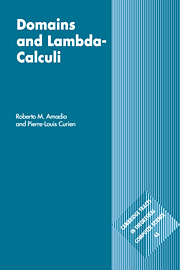Book contents
- Frontmatter
- Contents
- Preface
- Notation
- 1 Continuity and computability
- 2 Syntactic theory of the λ-calculus
- 3 D∞ models and intersection types
- 4 Interpretation of λ-calculi in CCC's
- 5 CCC's of algebraic dcpo's
- 6 The Language PCF
- 7 Domain equations
- 8 Values and computations
- 9 Powerdomains
- 10 Stone duality
- 11 Dependent and second order types
- 12 Stability
- 13 Towards linear logic
- 14 Sequentially
- 15 Domains and realizability
- 16 Functions and processes
- Appendix 1 Summary of recursion theory
- Appendix 2 Summary of category theory
- References and bibliography
- Index
3 - D∞ models and intersection types
Published online by Cambridge University Press: 05 November 2011
- Frontmatter
- Contents
- Preface
- Notation
- 1 Continuity and computability
- 2 Syntactic theory of the λ-calculus
- 3 D∞ models and intersection types
- 4 Interpretation of λ-calculi in CCC's
- 5 CCC's of algebraic dcpo's
- 6 The Language PCF
- 7 Domain equations
- 8 Values and computations
- 9 Powerdomains
- 10 Stone duality
- 11 Dependent and second order types
- 12 Stability
- 13 Towards linear logic
- 14 Sequentially
- 15 Domains and realizability
- 16 Functions and processes
- Appendix 1 Summary of recursion theory
- Appendix 2 Summary of category theory
- References and bibliography
- Index
Summary
In this chapter we address the fundamental domain equation D = D → D which serves to define models of the untyped λ-calculus. By ‘equation’, we actually mean that we seek a D together with an order-isomorphism D ≅ D → D. Taking D = {⊥} certainly yields a solution, since there is exactly one function f: {⊥} → {⊥}. But we are interested in a non-trivial solution, that is a D of cardinality at least 2, so that not all λ-terms will be identified! Domain equations will be treated in a general setting in chapter 7.
In section 3.1, we construct Scott's D∞ models as order theoretical limit constructions. In section 3.2, we first define a general notion of λ-model, and then discuss some specific properties of the D∞ models: Curry's fixpoint combinator is interpreted as the least fixpoint operator, and the theory induced by a D∞ model can be characterized syntactically, using Böhm trees. In section 3.3, we present a class of λ-models based on the idea that the meaning of a term should be the collection of properties it satisfies in a suitable ‘logic’. This point of view will be developed in more generality in chapter 10. In section 3.4, we relate the constructions of sections 3.1 and 3.3, following [CDHL82]. Finally, in section 3.5, we use intersection types as a tool for the syntactic theory of the λ-calculus [Kri91, RdR93].
- Type
- Chapter
- Information
- Domains and Lambda-Calculi , pp. 43 - 70Publisher: Cambridge University PressPrint publication year: 1998



